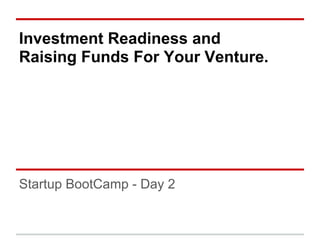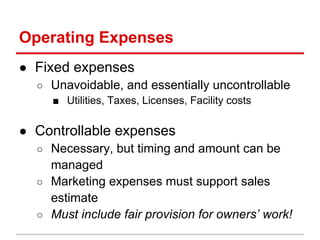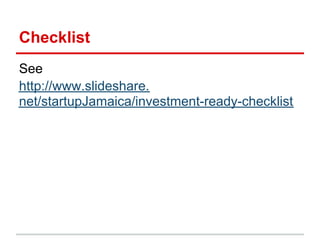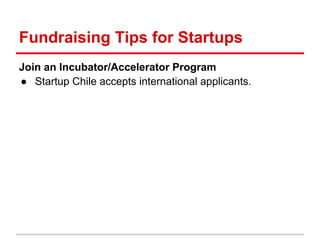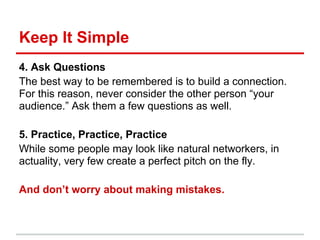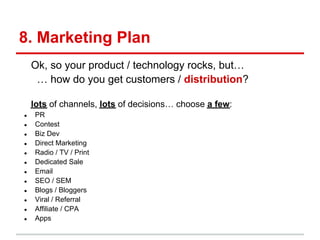Workshop #4
- 1. Investment Readiness and Raising Funds For Your Venture. Startup BootCamp - Day 2
- 2. Agenda 2:00 - 3:00 - Presentation 3:00 - 4:30 - Work on Pitch Deck
- 4. Entrepreneurs Everywhere Worrying About Financing!
- 5. What We'll Cover in This Workshop ● Defining how much funding you need. ● Investment Readiness Checklist (what you need to do before approaching investors). ● Sources of funding ● Techniques on how to develop a pitch deck.
- 6. Economic Feasibility ● At what full cost can it be done? ● At what price would there be significant demand for it? ● Is there enough of a gap between this price and full costs to allow for profit?
- 7. Economic Feasibility ● What will the business generate once it is up and running as a “going-concern?” ● How much financing will it take to get to that stage? ● What return on investment will that be?
- 8. Projected Income Statement ● Sales Estimate ● Cost of Sales ● Operating Expenses ○ Fixed ○ Controllable ● Profit before interest and taxes
- 9. Projected Sales ● Top down approach ○ What share of the market can we capture? ■ From which competitor(s) will this be taken? ● Bottom up approach ○ How much business from each entity in our target market do we need? ■ Reality check against present buying behaviour? ● Pricing will be a factor in both cases
- 10. Operating Expenses ● Fixed expenses ○ Unavoidable, and essentially uncontrollable ■ Utilities, Taxes, Licenses, Facility costs ● Controllable expenses ○ Necessary, but timing and amount can be managed ○ Marketing expenses must support sales estimate ○ Must include fair provision for owners’ work!
- 11. How Much Do You Need (Much) More than you think! Inadequate financing is the primary cause of new venture failures
- 12. Investment Readiness Investors like to see: ● Managers with a stake in the business – Investors want to see key managers ‘in the loop’ and working towards capital growth, not just on a salary. ● Healthy balance sheets – Debt as part of working capital is fine, but investors are looking to invest to grow and develop your business, not pay off your debts. ● Realistic projections – Your cash flows and financial projections must be open, detailed and realistic, as they will be intensely scrutinised by investors.
- 13. Investment Readiness An Excellent Team. A great management team can add to the good impression created by sound financials or a revolutionary product. ● Investors look for a well-knitted, adaptable and committed team that enjoys what they do.
- 15. Fundraising Tips for Startups ● Put your startup on AngelList – (angel.co) ●Check out raising capital for startups and what to include in your pitch slides. This online course consists of 8 lectures and over 6.5 hours of content (including a sample pitch deck) . $19. ●PitchEnvy has over 20 recent pitch decks that raised money!
- 16. Fundraising Tips for Startups Create an intro video as a teaser ● Helps establish the concept of your startup in a clear/clever/fun way for users and investors alike. ● PowToon, an Israeli startup, is another free tool to help. ●Equity Crowdfunding ● FundersClub (US),Seedrs (UK), and CrowdCube (UK, mostly non-tech) ● anyone (not just accredited angel investors), put small sums as little as $1000 towards an equity investment in a startup.
- 17. Fundraising Tips for Startups Donation Crowdfunding ● Platforms like Kickstarter, Rally and IndieGogo are essentially early-sales platforms ● Works especially well for physical products.
- 18. Fundraising Tips for Startups Join an Incubator/Accelerator Program ● Startup Chile accepts international applicants.
- 19. Pitch Deck vs. Business Plan Feasibility Study ● Can it be done (realistically)? Business Plan ● I / we can do it successfully (and here’s how) Pitch Deck ● I / we will make it happen (if you invest)
- 20. Pitch Decks: Keep It Simple!
- 21. Keep it Simple 1. Have a great one-liner 2. Know your audience 3. Keep it to 10-15 slides 4. Beware of the demo 5. Expect the deck to be shared
- 22. Keep it Simple 1. Find the Sweet Spot Get Specific! Focus on the problems you solve… “my clients are typically struggling to…and I help them…” 2. Speak Like a Human Being Yes, you should prepare and practice your pitch, but it should always be simple, natural, and in plain English. 3. Exude Confidence When answering what you do, don’t mumble through the response. Definitely never sound as if you’re apologizing.
- 23. Keep It Simple 4. Ask Questions The best way to be remembered is to build a connection. For this reason, never consider the other person “your audience.” Ask them a few questions as well. 5. Practice, Practice, Practice While some people may look like natural networkers, in actuality, very few create a perfect pitch on the fly. And don’t worry about making mistakes.
- 24. Components of a Pitch Deck 1. Elevator Pitch 2. The Problem 3. Your Solution 4. Market Size 5. Business Model 6. Proprietary Tech 7. Competition 8. Marketing Plan 9. Team / Hires 10. Money / Milestones
- 25. 1. The Elevator Pitch ● Short, Simple, Memorable: “What, How, Why.” ○ “We’re X for Y” is ok if 1) it’s true 2) X & Y are well-known ● Max 3 key words / phrases, 2 sentences. ○ “SlideShare is the world’s largest community for sharing presentations. ○ “TeachStreet is a place to teach or learn anything.” ○ “Mint.com is the free, easy way to manage your money online.” ● Logo and/or Image ok but not rqd ● No “Inside Baseball” lingo ○ make it easy for non-experts to understand. ● Smile. It’s ok to have fun when you pitch ☺
- 26. Zap Meals “ZapMeals is an online meal order & delivery service matching hungry consumers with great local food preparers.” “We’re eBay for takeout orders.”
- 27. 2. The Problem What is The Problem? Make it Obvious. ● “Ouch. Yeah, I have that too…” Who has it? How Many? How do you know? ● stats, examples, research, links. “Painkiller not Vitamin” ● Vitamins are great, but you NEED painkillers. BAD.
- 28. Zap Meals Problem: Great Fast Food… Isn’t Either. Preparers ● Is there a market for my cooking? ● Restaurants have high startup costs ● Delivery is tough to do fast, warm, & well Consumers ● Tough to find good fast food ● What’s the best / cheapest / fastest place to order from? ● It’s been 30 minutes – where’s my order?
- 29. 3. Your Solution Describe why your Solution: ● Makes customers very happy ● Does it better, different than anyone else ● Remember “NICHE to WIN” (Customer Case Study can also go here)
- 30. Demo of Product ● If you’re doing live demo: PRACTICE! PRACTICE! PRACTICE! ● Expect demo to FAIL – in multiple, interesting ways -- how will u handle it? ● Always have a backup (screenshots, local video) ● Expect to be interrupted
- 31. Demo of the Product
- 32. 4. The Market Bigger is Better Top Down = someone else reported it ● Forrester, Gartner, Your Uncle Bottom Up = calculate users/usage/rev$ ● Avg Txn = $X ● Y customers in our market ● Avg customer buys Z times per year ● Market Size = $X * Y * Z annually = a big friggin’ # ● Market growing @ 100+% per year
- 33. 5. The Business Plan Describe Top 1-3 Revenue Sources ● Prioritize by Size, Growth, and/or Potential ● Cite current market activity / customer behavior as proof Show How You Get to Break-even (or Profitable) ● Ideally, on the current round of funding you’re raising Common Revenue Models ● Direct: ecommerce, subscription, digital goods, brands ● Indirect: advertising, lead gen, affiliate / CPA
- 34. Zap Meals: 3 Ways to Make Money ● Transactional: ● charge a 15% food prep fee (min $1) ● charge a 15% food delivery fee (min $1) ● Advertising: ● charge small preparers by click-thru (SEM for food) ● charge larger preparers for premium / sponsored listings ● Supplies, Equipment, Insurance: ● provide supplies, education for ZapMeals preparers ● free licensing to ZapMeals preparers who buy $250 eqpmt ● insure against food inspection issues via large group
- 35. 6. Proprietary Tech, Expertise VCs *really* like unfair advantage ● big market lead ● experienced team ● ex-Google PhDs ● core / “breakthrough” tech ● “defensible” IP / patents ● “exclusive” partnership ● great sales/market
- 36. Zap Meals Proprietary Technology ZapMeals has developed a proprietary least-cost routing & matching algorithm for ordering & delivery Our Secret Sauce:”Search by Takeout Time” ● estimated food preparation time (historical) ● delivery distance (how far away ● delivery provider (on-time record) ● delivery stats real-time via GoogleMaps (+ GPS)
- 37. 7. Competition ● List all top competitors ● (especially top ones; we’ll find them anyway) ● Say how you’re better, or at least different ● If not better or different -> “NICHE TO WIN” ● position(-ing) matters ● 2-axis graph is trite, but still useful ● see next page for example ● useful comparisons / differentiation: ● simple vs complex ● value vs cheap (tougher to prove tho) ● cheap vs expensive (but careful you don’t race to bottom) ● consumer vs enterprise ● open vs proprietary (in this case, open usually better… but not always)
- 38. 8. Marketing Plan Ok, so your product / technology rocks, but… … how do you get customers / distribution? lots of channels, lots of decisions… choose a few: ● PR ● Contest ● Biz Dev ● Direct Marketing ● Radio / TV / Print ● Dedicated Sale ● Email ● SEO / SEM ● Blogs / Bloggers ● Viral / Referral ● Affiliate / CPA ● Apps
- 39. Marketing Plan ● Online ● Partner with notable foodie bloggers ● Adwords Campaigns to regional west coast metros ● Generate SEO traffic via food listing pages ● Offline ● Distribution Partnership with CA Restaurant Assoc. (700 in SF) ● Contest for Best Ethnic Restaurants (10 x 10 winners, prizes) ● PR stunt / TV spot for “Fastest Food Delivery in San Francisco”
- 40. 9. The Team Key People ● Geeks with deep technical background ● Entrepreneurs who have sold companies ● Sales/Marketing who Make it Rain Also Identify: ● Key Hires you Need but *Don’t* Have, and… ● … you’ve got candidates lined up in those areas ● ... ready to hire as soon as you close funding ● … or at least job descriptions / est. salary
- 41. 10. Money, Milestones ● How Much Money Raised / Now Raising? ● Show 3 Budgets: Small, Medium, Large ● Show how you’ve got “Small” already lined up ● Show “Optionality”, Competitive Interest (if poss.) ● What Will you Do with the Capital? ● Key Hires (Build Product) ● Marketing & Sales (Drive Revenue) ● CapX, Ops Infrastructure (Scale Up) ● Map Out Achievable Milestones with Non-Linear Increase in Value ● Show what will get you to next milestone (product, customers, hires) ● Show how the capital you have is more than adequate ● Show substantial UPTICK in value when milestone is achieved ● functional product ● initial customers / revenue ● break-even or profitable
- 42. Financials Raised $200K Seed round Jan 08 @ $1M valuation ● angel investors: Ron Conway, Larry Page, Bill Gates ● built initial prototype; functional use with 1000 customers Seeking $500K-$1M Series A round @ $2.5M valuation ● already closed $300K ● meetings with 5 other VCs in next 2 weeks ● targeted closing in 4 weeks Use of Proceeds / Product Roadmap / Goals ● $300-500K: hire 2-3 engineers, 1 marketing / sales, .5 PT customer support ● $200-500K: marketing campaigns & customer acquisition ● get to 25K customers, $1M revenue by end of year ● estimated break-even in Q4 / 09 @ $100K / month
- 43. One Last Thing Close with a Bang Leave ‘em Wanting More Show Interest in next date Leave them a Memento ● educate them on market report ● send link to private beta “oh, and One More Thing...”
- 44. More Info ● Dave McClure: ○ Startup Metrics for Pirates (AARRR!) ○ ZapMeals Sample Pitch Presentation ○ Master of 500 Hats Blog: “Greatest Hats” (top blog posts) ● Steve Blank: 4 Steps to Epiphany, Customer Development Methodology ● Eric Ries: StartupLessonsLearned ● Sean Ellis: Startup-Marketing.com ● Andrew Chen: AndrewChenBlog.com ● Brad Feld, Jason Mendelson: AskTheVC.com ● VentureHacks.com ● StartupCompanyLawyer.com
